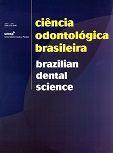Utilização de vídeo como recurso complementar de ensino em dentística operatória
DOI:
https://doi.org/10.14295/bds.2009.v12i3.624Abstract
A diversificação das práticas pedagógicas tem sido adotada visando o aprimoramento do processo de ensino. Elaborou-se um vídeo sobre a técnica de restauração em amálgama na disciplina de Dentística Operatória da Faculdade de Odontologia de São José dos Campos – UNESP. O vídeo foi apresentado na aula expositiva, ao término da apresentação de slides, visando a melhor fixação do conhecimento e disponibilizado na Internet (http://www.fosjc.unesp.br/dentistica/paginas/ DentisticaI-noturno/paginas/Home.htm) . O objetivo desse estudo foi avaliar a opinião dos alunos sobre a validade do vídeo como facilitador da compreensão do assunto e da execução dos procedimentos laboratoriais. Foi aplicado um questionário aos alunos (n=78), com questões fechadas relativas ao aproveitamento do vídeo. Após a coleta dos resultados, os dados foram submetidos à análise estatística descritiva. Observou-se que 100% dos alunos consideraram o vídeo como um recurso facilitador da compreensão e execução laboratorial da técnica; 94,87% observaram a melhora do processo de aprendizagem decorrente da visão dinâmica apresentada no vídeo em comparação à visão estática proporcionada pelos slides. Apenas 29,49% consideraram o vídeo como substituto adequado à demonstração prática dada pelo professor. Somente 28,20% acessaram o vídeo na internet após a aula e 8,97% o indicaram a outra pessoa. Concluiu-se que a apresentação do vídeo representou um recurso complementar de ensino válido e aprovado pelos alunos, contudo, não substituiu o contato aluno/professor proporcionado durante as demonstrações práticas. Em adição, o acesso do site pela Internet deve ser mais incentivado.
Downloads
Downloads
Published
How to Cite
Issue
Section
License
Brazilian Dental Science uses the Creative Commons (CC-BY 4.0) license, thus preserving the integrity of articles in an open access environment. The journal allows the author to retain publishing rights without restrictions.
=================




























